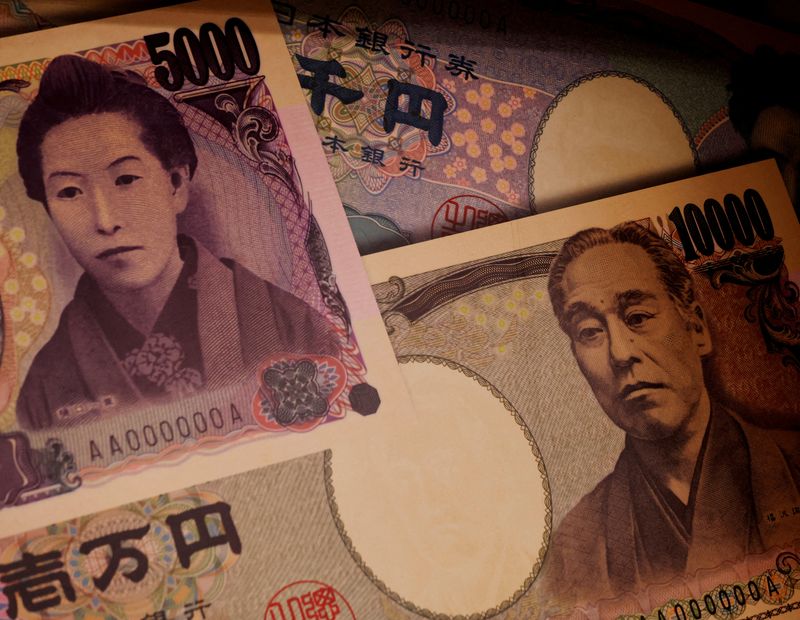By Alun John and Tom Westbrook
LONDON/SINGAPORE (Reuters) -The Bank of Japan's move to raise interest rates to their highest in 15 years has jolted the yen to its strongest against the dollar since March and left it poised for further gains, as investors reassess carry trades, once the year's favoured play.
The shift will come as a relief to Japan's Ministry of Finance which spent 5.53 trillion yen ($37 billion) in the foreign exchange market to prop up their currency this month, Wednesday data showed, their second batch of intervention of the year.
Wednesday's rate hike was the largest since 2007 and came just months after the BOJ ended eight years of negative interest rates. Governor Kazuo Ueda, furthermore, did not rule out another hike this year and stressed the bank's readiness to keep raising borrowing costs to levels deemed neutral to the economy.
The dollar dropped 1.7% against the Japanese currency to 150.2 yen after the BOJ's move and is now over 10 yen lower than its early July level of 161.9.
That July level was the Japanese currency's weakest since 1986. The yen came under heavy pressure as benign market conditions and a wide gap between borrowing costs in Japan and those elsewhere meant it was a popular choice as a funding currency for carry trades.
These see investors borrow in a currency where interest rates are low - the yen has been popular - and then swap them for another currency in which they can invest in higher yielding assets.
They had been very popular with investors earlier in the year as global rate cuts that had been expected early in 2024 got pushed back, and currency prices were stable - sudden swings in price can wipe out gains from yield differentials.
But with the BOJ raising rates at a time when cuts by central banks around the world finally gather pace, investors are changing tack.
"It's the rate of change (of interest rate differentials) that matters. And so if the BOJ are stepping up the pace of rate hikes relative to market pricing, and if the Fed is also becoming in play here, then the pressure on the carry trade increases," said James Malcolm, head of FX strategy at UBS.
The Federal Reserve held interest rates steady on Wednesday but opened the door to reducing borrowing costs as soon as its next meeting in September as inflation continues coming into line with the U.S. central bank's 2% target.
"Hedge funds are likely reassessing their strategies in light of these developments," said Tareck Horchani, head of prime brokerage dealing at Maybank Securities in Singapore.
"This shift could diminish the attractiveness of short yen positions, as the narrowing rate differential between the BOJ and other central banks, particularly the Fed which is expected to cut in September and December, makes the yen less appealing for carry trades."
PACE AND VOLATILITY
While it is difficult to gauge the exact amount of global positions in yen-funded carry trades, and hence the impact their unwinding could have on the currency, a lot of speculative positions are based on pure currency swaps between the yen and higher yielding currencies.
There are hundreds of billions of dollars worth of yen-funded short-term investments too.
Yen-funded carry trades in U.S. Treasuries, for example, yield nearly 6% - a mighty incentive for market participants that has so far been hard for Japan to counter. The BOJ's 15 basis points rate rise will only marginally erode the 'carry' on such trades.
But what could upend the trades and force liquidation is volatility.
"The carry trade works when volatility is low, but if that volatility goes up, people will unwind positions," said Yusuke Miyairi FX strategist at Nomura.
That is rising, and dollar/yen overnight implied volatility jumped to 27% on Wednesday, its highest level this year.
It is not just Wednesday's BOJ move that has jolted the yen, as the MOF's intervention earlier in July stopped the currency's slide. Remarks from Republican presidential candidate Donald Trump criticising Japan for the yen's weakness, and the changing Fed expectations were in the mix.
Those factors have already seen carry trades get unwound, with knock on effects on currencies from Mexico to Switzerland.
CFTC data shows speculators' bearish bets against the yen are 40% below April's near-seven year high, though at a still elevated $8.61 billion.
And there is still scope for the yen's moves to get more dramatic.

"You can't discount the notion that we might have a single day move of five or seven or even like the historic extremes of 10 (yen) in a single day," said UBS' Malcolm.
"In 1998, we had two consecutive days of 10 (yen) moves in dollar/yen. That's what carry trade unwinds look like. That's what we've seen in the past and that's what the setup still looks like today."